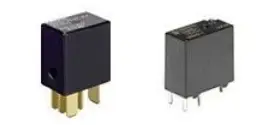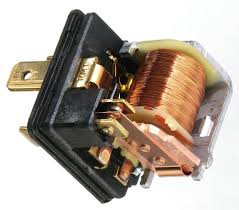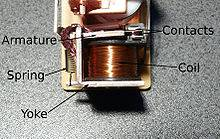

Introduction to Automotive Relay
Catalog
What Is an Automotive Relay?Automotive Relay FeaturesApplications and Benefits of Automotive Relays:Design of Automotive Relay Circuits:Final WordsFrequently Asked QuestionsRelated ArticlesWhat Is an Automotive Relay?
An automotive relay s a pivotal device in the realm of standalone ECUs, where dependable electrical power is paramount. The capacity to promptly and reliably distribute and toggle various electrical circuits is essential for both engine and body electrical management systems. This functionality is heavily dependent on a key component: the automotive relay. Essentially, an automotive relay is a switch that is controlled by electronic means. The predominant variety in the automotive sector is the electro-mechanical type of switch. These are ubiquitous across all vehicle types, including automobiles, lorries, minivans, semi-trailers, and marine vessels. They use an electromagnet to physically operate a switch, either connecting or disconnecting an electrical circuit.The automotive sector predominantly utilizes compact, cube-shaped standard or mini relays as their go-to type.
Automotive Relay Features
Automotive relays come in two main forms: those that are directly connected to a vehicle, such as in the engine compartment, through a plug-in mechanism, and those that are integrated onto a manufacturer's printed circuit board.
Plug-in relay
Interchangeable relays featuring tab terminals designed for straightforward connection to a vehicle's connector or relay box.
Relay for printed circuit boards
This type is installed on the printed circuit board by the original equipment manufacturer, and after being installed, the relay cannot be replaced individually.

Plug-in relay vs Relay for printed circuit boards
Applications and Benefits of Automotive Relays:
1. Handling High-Current Circuits:
Automotive relays are predominantly used for switching high-current circuits with a low-current circuit. This is particularly useful when an in-line switch lacks the capability to handle the current demands of a high-current electrical system. For instance, when high-powered work lamps are wired to turn on with the headlights, they might overload the existing wiring. An automotive relay can effectively manage this issue.
2. Controlling Multiple Circuits with One Switch:
One significant benefit of relays is their ability to activate multiple circuits from a single switch. A single input in an electrical system can trigger multiple relays, which in turn can open or close several circuits and perform various functions with just one input signal. A practical example is a car's central locking system, where pressing one button can lock or unlock all the doors simultaneously. This is a straightforward, time-saving, and efficient solution.
3. Implementing Logic Functions:
Although modern vehicles often use electronic modules instead of relays for logic operations, relays can still perform both simple and complex logical tasks. They can handle momentary inputs and time-controlled functions, such as the timed operation of windshield wipers or the delayed turn-off of interior lights. While manufacturers prefer programmable logic for these tasks, relays offer a cost-effective and straightforward alternative, especially appealing to car enthusiasts for simple logic implementations.
4. Cost-Effectiveness:
High-current electrical components are costly, whereas low-current components are much more affordable. By using automotive relays, you can restrict the use of high-current components to only the essential parts of the system. Installing relays at strategic points allows the rest of the circuit to be completed with less expensive low-current components, reducing overall costs and increasing satisfaction for all stakeholders.

Automotive Relay
Design of Automotive Relay Circuits:
The majority of automotive relays you encounter are typically either Single-Pole, Single-Throw (SPST) or Single-Pole, Double-Throw (SPDT) types, which consume a minimal amount of current (typically less than 200 milliamps). These relays feature contacts that can be either normally closed (NC) or normally open (NO), capable of handling current loads up to 30 or 40 amps. The operation of these relays involves two main circuits:
1. Control Circuit:
- This circuit includes the relay's coil.
- Upon the application of power to the coil, a magnetic field is produced.
2. Load Circuit:
- The relay governs the switch within this circuit.
- The magnetic field created by the energized coil interacts with the relay's mechanism, causing the switch to either open or close.
The switching action of the relay is determined by the polarity of the current flowing through the coil. Here's a brief overview of how each type operates:
- SPST Relay:
- With an SPST relay, there is one set of contacts: one normally open contact that closes when the coil is energized.
- This type of relay is used when you need to control a single circuit with a single switch.
- SPDT Relay:
- An SPDT relay has two sets of contacts: one normally open and one normally closed.
- When the coil is energized, the normally open contact closes, and the normally closed contact opens.
- This type is useful for switching between two different states or circuits, such as in applications where you might need to alternate between two power sources or control paths.
Final Words
In summary, automotive relays are designed to allow a low-current signal to control a high-current load, making them ideal for various automotive applications where high currents need to be managed safely and efficiently.

Automotive Relay Circuit Design
Frequently Asked Questions
1. What is the purpose of automotive relays?
Automotive relays are extensively utilized in the electrical systems of vehicles. They serve not only to control various electrical components within the vehicle but also to safeguard wiring and equipment from excessive loads.
2. What kind of relay is employed in automobiles?
A car relay can be defined as an electronically controlled switch. The predominant type in the automotive sector is an electro-mechanical switch, which is present in all kinds of vehicles, including cars, trucks, vans, trailers, and boats.
3. When is it necessary to use a relay in a car?
A Power Relay is essential when you need to engage a high-power, heavy-load device with a small, low-load switch.
4. What is the cost of replacing a car relay?
The cost of an aftermarket relay typically falls between $50 and $250, with variations depending on factors such as brand, quantity, fitment, and condition. The labor cost for this replacement generally ranges from $30 to $60.
5. What does the main relay in a car do?
The main relay, situated in the vehicle's fuse box (usually under the passenger-side dashboard or in the engine compartment), connects and manages the fuel system and the Powertrain Control Module (PCM).
6. Which relay is most frequently used?
The current relay is the most frequently utilized component in power system relay protection. It is favored for its straightforward wiring, quick and dependable operation, easy maintenance, and extended service life.
7. What distinguishes a relay from a contactor?
Relay activation is triggered by an external source, while contactors possess an internal control system that can be activated by various means, such as manual switches, voltage, or current levels. Additionally, contactors are generally larger than relays due to their higher load capacity.
8. What is the expected lifespan of a relay?
General-purpose and power relays generally have an electrical life expectancy of at least 100,000 operations, meaning they can switch on and off 100,000 times before they might fail. The actual service life can differ based on factors like load conditions, operating environment, and maintenance.
9. What is the most typical automotive relay?
Make & break relays are referred to as Single Pole Single Throw (SPST), and changeover relays as Single Pole Double Throw (SPDT) based on standard switch terminology. While there are other contact configurations, make & break and changeover relays are the most widely used.
Related Articles
Subscribe to JMChip Electronics !



















